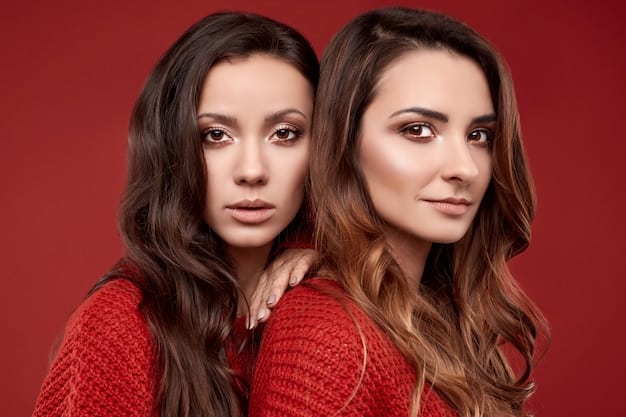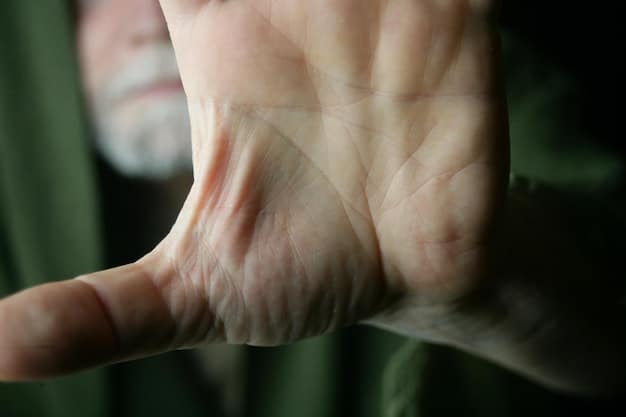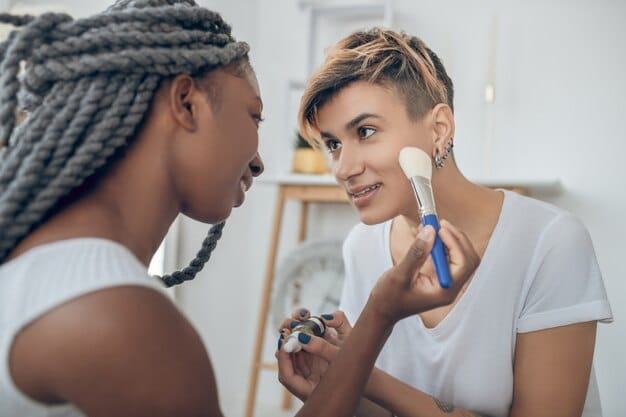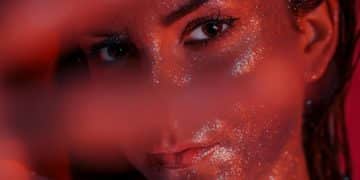Undertones Unveiled: Your 2025 Guide to Perfect Makeup Colors

The 2025 Guide to Understanding Undertones: Choosing the Right Makeup Colors for Your Skin provides essential insights into identifying your skin’s undertones, enabling you to select makeup shades that enhance your natural beauty and create a flawless, harmonious look.
Finding the perfect makeup can feel like navigating a maze. But what if the secret wasn’t about following trends but understanding your skin’s unique blueprint? Welcome to The 2025 Guide to Understanding Undertones: Choosing the Right Makeup Colors for Your Skin, your compass to a flawless, naturally radiant look.
Understanding Skin Undertones: The Foundation of Flawless Makeup
Skin tone is often confused with skin undertone, but they are distinct concepts. Skin tone refers to the surface color of your skin (fair, medium, dark), while undertone is the subtle hue beneath the surface. Understanding your skin undertone is crucial because it determines which makeup colors will harmonize with your complexion, creating a natural and flattering effect.
What are Skin Undertones?
Skin undertones can be broadly categorized into three main types: warm, cool, and neutral. Warm undertones have hints of yellow, peach, or gold. Cool undertones have hints of pink, red, or blue. Neutral undertones are a balance of warm and cool, making them versatile and adaptable to various makeup shades.
Why Undertones Matter in Makeup Selection
Choosing makeup based on your undertone prevents the dreaded “makeup mask” effect, where your face appears disconnected from your neck and body. Colors that complement your undertone will seamlessly blend with your skin, enhancing your natural radiance and creating a cohesive, polished look.
- Warm Undertones: Opt for makeup with golden, bronze, or warm peach hues.
- Cool Undertones: Choose makeup with pink, red, or cool beige hues.
- Neutral Undertones: You have the freedom to experiment with a wide range of colors, but pay attention to the intensity of the shades.
By mastering the art of identifying your undertones, you’re one step closer to achieving a truly personalized and flattering makeup look.
Methods to Determine Your Skin Undertone
Discovering your skin’s undertone involves a bit of detective work. Fortunately, there are several tried-and-true methods to help you accurately identify whether you have warm, cool, or neutral undertones.
The Vein Test
One of the simplest and most popular methods is the vein test. In natural light, examine the veins on your wrist. If your veins appear blue or purple, you likely have cool undertones. If they appear green, you likely have warm undertones. If you see a mix of both blue and green, you probably have neutral undertones.
The Jewelry Test
Another helpful method involves assessing how your skin looks with different types of jewelry. If gold jewelry complements your skin and makes it glow, you likely have warm undertones. If silver jewelry looks better against your skin, enhancing your complexion, you probably have cool undertones. If both gold and silver look equally good, you may have neutral undertones.

The White vs. Off-White Test
This test involves holding up a piece of pure white fabric and then a piece of off-white or cream fabric next to your face in natural light. Observe which shade makes your skin look brighter and more radiant. If your skin looks better against the off-white fabric, you likely have warm undertones. If it looks better against the pure white fabric, you probably have cool undertones. If both shades look equally flattering, you may have neutral undertones.
Combining these methods provides a comprehensive approach to pinpointing your skin’s undertone. Remember, it’s possible to have a combination of undertones, but one will usually be more dominant.
Makeup Colors for Warm Undertones
If you’ve determined that you have warm undertones, you’re in luck! A range of makeup colors can enhance your natural golden or peachy complexion, creating a radiant and sun-kissed appearance.
Foundation and Concealer
When selecting foundation and concealer, opt for shades with yellow or golden undertones. These will seamlessly blend with your skin, neutralizing any redness and creating a smooth, even base. Avoid foundations with pink or ashy undertones, as they can make your skin look dull.
Eyeshadow
Warm eyeshadow shades like bronze, gold, copper, and warm brown will beautifully accentuate your eyes. Experiment with sunset-inspired palettes for a captivating and dimensional look. For a subtle daytime look, try a wash of champagne or golden beige.
Blush and Bronzer
For blush, reach for shades like peach, coral, and warm rose. These will add a natural flush to your cheeks, creating a healthy and vibrant glow. Bronzer should be golden or bronze-toned to mimic a sun-kissed tan. Avoid cool-toned or overly pink blushes, as they can clash with your warm undertones.
- Foundation: Choose yellow or golden undertones.
- Eyeshadow: Opt for bronze, gold, or warm brown shades.
- Blush: Select peach, coral, or warm rose hues.
By embracing these warm-toned makeup colors, you can enhance your natural radiance and create a harmonious, glowing look that celebrates your warm undertones.
Makeup Colors for Cool Undertones
If your skin has cool undertones, characterized by hints of pink, red, or blue, a range of makeup colors can enhance your complexion, creating a fresh and vibrant look.
Foundation and Concealer
When choosing foundation and concealer, look for shades with pink, rose, or cool beige undertones. This will help to even out your skin tone and create a flawless base. Avoid foundations with yellow or golden undertones as they can make your skin look sallow.
Eyeshadow
For eyeshadow, opt for cool-toned shades like silver, blue, purple, and cool gray. These colors will complement your cool undertones, making your eyes pop. For a natural daytime look, try a soft lavender or cool taupe.

Blush and Lipstick
For blush, choose shades like pink, berry, and cool rose. These colors will give your cheeks a natural flush and enhance your complexion. When it comes to lipstick, cool-toned reds, pinks, and purples are excellent choices. Avoid warm-toned oranges and browns, as they can clash with your cool undertones.
Selecting makeup shades that complement your cool undertones will ensure a harmonious and flattering look, enhancing your natural beauty and creating a polished finish.
Makeup Colors for Neutral Undertones
Having neutral undertones is like winning the makeup lottery! With an equal balance of warm and cool hues in your skin, you can experiment with a wider range of colors than those with distinct warm or cool undertones. However, there are still some guidelines to keep in mind to achieve the most flattering results.
Foundation and Concealer
When selecting foundation and concealer, look for shades labeled as “neutral” or those that appear to have a balance of both yellow and pink undertones. It’s essential to find a shade that matches your skin tone closely without leaning too heavily in either the warm or cool direction.
Eyeshadow
The world is your oyster when it comes to eyeshadow! Experiment with both warm and cool shades to see what you prefer. Neutral browns, taupes, and grays are always a safe bet for a natural look. For a more dramatic effect, try jewel tones like emerald green, sapphire blue, or amethyst purple.
Blush and Lipstick
For blush, you can wear a variety of shades, but consider your skin tone. Fair skin tones look great in soft pinks and peaches, while medium skin tones can handle brighter corals and roses. Dark skin tones can pull off deeper berries and plums. With lipstick, similar principles apply. Experiment with different shades and finishes to find what you love.
- Foundation: Opt for true neutral shades.
- Eyeshadow: Experiment with both warm and cool tones.
- Blush: Consider your skin tone when choosing shades.
With your versatile neutral undertones, the possibilities are endless when it comes to makeup. Have fun exploring and discovering your favorite combinations!
Beyond Color Selection: Tips for a Flawless Application
Choosing the right makeup colors based on your undertone is a crucial first step. However, mastering the art of flawless makeup application involves more than just color selection. Here are some additional tips to elevate your makeup game:
Prep Your Skin
A smooth, hydrated canvas is essential for achieving a flawless makeup look. Start by cleansing your skin thoroughly and applying a moisturizer that suits your skin type. If you have oily skin, opt for a lightweight, oil-free moisturizer. If you have dry skin, choose a richer, more hydrating formula.
Use the Right Tools
Investing in high-quality makeup brushes and sponges can make a world of difference in the application process. Use a foundation brush or sponge to apply your foundation evenly, blending it seamlessly into your skin. Use a smaller brush to apply concealer to targeted areas, such as under the eyes and around the nose.
Blend, Blend, Blend
Blending is the key to creating a natural, airbrushed finish. Use a clean brush or sponge to blend out any harsh lines or edges. Pay particular attention to blending your foundation into your hairline and jawline to avoid a noticeable line of demarcation.
By incorporating these tips into your routine, you can enhance the overall look and longevity of your makeup, ensuring a flawless and radiant complexion every time.
| Key Concept | Brief Description |
|---|---|
| ✨ Undertones | Subtle hues beneath the skin surface (warm, cool, neutral). |
| 🎨 Warm Undertones | Best with golden, bronze, or peach makeup shades. |
| ❄️ Cool Undertones | Best with pink, red, or cool beige makeup shades. |
| ⚖️ Neutral Undertones | Versatile; balance intensity of shades. |
Frequently Asked Questions (FAQ)
▼
If both gold and silver jewelry look equally flattering on your skin, and your veins appear to be a mix of blue and green, you likely have neutral undertones. Your skin also looks good in both pure white and off-white clothing.
▼
While your skin tone can change due to sun exposure or skin conditions, your undertone generally remains the same throughout your life. It’s a constant characteristic of your complexion you can rely on.
▼
Wearing makeup colors that clash with your undertone can make your skin look dull, ashy, or even unnatural. The makeup might appear to sit on top of your skin rather than blending seamlessly.
▼
Yes, olive undertones are a variation of neutral undertones that have a greenish or yellowish hue. People with olive undertones often find that traditional warm or cool makeup shades don’t quite suit them.
▼
Many makeup brands now offer products specifically formulated for different undertones. Look for labels that mention “warm,” “cool,” or “neutral.” Online shade finders can also help you determine your best matches.
Conclusion
Understanding your skin’s undertones is key to unlocking your most radiant and harmonious makeup looks. By identifying whether you have warm, cool, or neutral undertones and selecting makeup colors that complement your complexion, you can achieve a flawless and naturally beautiful finish that enhances your unique features.





